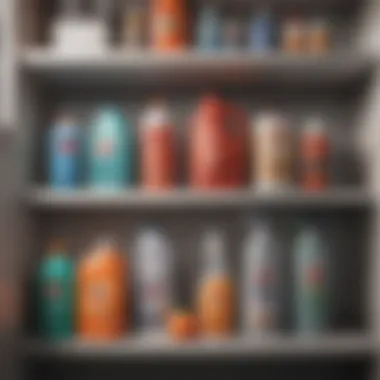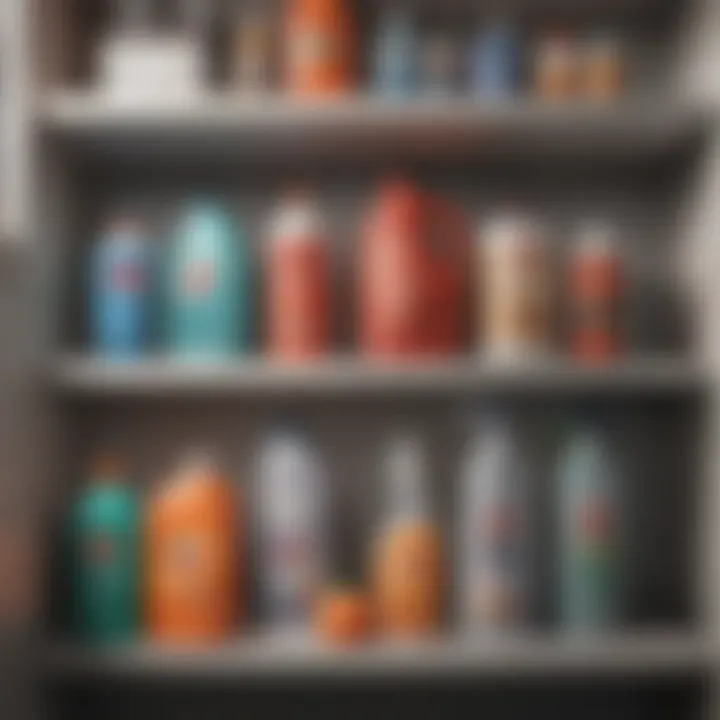Essential Cleaning Supplies and Strategies


Intro
Cleaning a home is not merely about aesthetics; it is crucial for health, comfort, and longevity of your living space. An essential aspect of home maintenance is choosing the right cleaning supplies. Different tasks require specific tools and materials for effectiveness and efficiency. Additionally, as the importance of sustainability continues to rise, integrating environmentally friendly products into your cleaning routine is important. This article aims to delve into the essential supplies necessary for cleaning various spaces within the home, as well as the strategies that can help in maintaining a pristine environment.
We will categorize supplies based on their specific functions. Moreover, the article will provide insights on how to implement effective cleaning methods that align with a more sustainable living approach. Understanding these elements can enhance both the aesthetic and practical aspects of home maintenance.
Design Inspiration
Although the focus of this guide is on cleaning supplies and strategies, understanding the design elements of your home can enhance your cleaning experience. Keeping a clean home is often tied to the home’s aesthetic. A well-designed space can motivate regular maintenance.
Current Interior Design Trends
Today’s trends favor minimalism and simplicity. This design ethos usually requires fewer decorative items, which can simplify cleaning. Elements such as open floor plans and multifunctional spaces can further optimize both cleaning and living. Using durable materials in furniture or flooring is favored, as they are easier to maintain and resist wear.
Additionally, biophilic design, which incorporates natural elements, can add a touch of freshness to a home. Indoor plants can enhance air quality while also serving as decorative elements that require specific cleaning techniques.
Color Palettes and Their Effects
Choosing the right color palette can affect the mood of a space and influence how often it feels clean. Lighter colors, like whites and soft pastels, can create an airy feel but may require more frequent upkeep to hide dirt. Conversely, darker shades or vibrant colors can conceal stains better, potentially reducing the need for constant cleaning.
Identifying the function and traffic of each area of your home is key when selecting a color scheme. Some areas may benefit from light colors, while others may fare better with darker tones.
"Understanding the intersection of design and cleaning can significantly improve your home maintenance experience."
Ensuring your home is not only functional but also aesthetically pleasing creates a welcoming environment that is easier to maintain. With a basic understanding of current trends and color impacts, you will be better equipped to make informed decisions about your cleaning supplies and strategies moving forward.
Prelims to Home Cleaning Essentials
Cleaning a home is not just about aesthetics; it is a critical part of maintaining a healthy living environment. A well-maintained home is essential for both physical and mental well-being. Therefore, understanding the fundamentals of cleaning supplies and strategies is crucial for homeowners, renters, and even interior design enthusiasts looking to create a serene space.
The effectiveness of home cleaning hinges on using the right supplies and strategies tailored to specific tasks. Each area in a home comes with its own unique cleaning requirements. For example, the kitchen has a higher need for degreasers, while bathrooms may require specialized mildew removers. This article aims to elaborate on these requirements and offer clear guidelines for selecting the appropriate cleaning supplies.
Moreover, effective home maintenance relies on strategic cleaning routines. Establishing a comprehensive cleaning schedule that incorporates daily, weekly, and monthly tasks not only simplifies the approach but also ensures that cleaning becomes a seamless part of everyday life.
For homeowners hosting frequent gatherings or gardening enthusiasts maintaining an outdoor space, understanding cleaning essentials is even more vital. Empowering oneself with knowledge about cleaning supplies enhances efficiency, allowing individuals to focus more on enjoying their space rather than just maintaining it.
"A clean environment reduces stress and promotes a more productive lifestyle."
Recognizing the importance of sustainability in modern cleaning practices is another key element. As we explore the landscape of cleaning supplies, we must consider eco-friendly alternatives and their benefits. This introduction sets the tone for a detailed exploration of essential cleaning agents, tools, strategies, and sustainable practices.
Equipping oneself with the right knowledge will not only simplify home maintenance but also improve the quality of the living space, making it a haven of comfort and well-being.
Understanding Cleaning Supplies
Cleaning supplies are crucial for maintaining any home environment. They provide the necessary tools and agents to remove dirt, grime, and bacteria. Understanding what cleaning supplies are available equips homeowners with the knowledge to choose the right products. This not only enhances the effectiveness of cleaning tasks but also promotes health and hygiene within the home. Furthermore, knowing the different classes of supplies can lead to better waste management practices and a more sustainable approach to cleaning.
Types of Cleaning Agents
Cleaning agents are the heart of any cleaning routine. They vary widely in formulation, purpose, and efficiency. Here, we will discuss three main types that are essential for most cleaning tasks.
All-Purpose Cleaners
All-purpose cleaners are widely used due to their versatility. They can tackle various surfaces like countertops, floors, and bathroom fixtures. The key characteristic of all-purpose cleaners is their ability to dissolve dirt and remove stains without needing multiple products. This makes them a popular choice for everyday use. One unique feature is their formulation, which often includes surfactants that lift grime away. However, while they are effective, they may not provide the same degree of disinfection as specialized cleaners designed for specific tasks.
Disinfectants
Disinfectants serve a specific role: killing pathogens on surfaces. Their importance cannot be overstated, especially in areas prone to bacteria, such as kitchens and bathrooms. A key characteristic of disinfectants is their chemical composition, which includes active ingredients like bleach or hydrogen peroxide. They are beneficial for ensuring a higher level of cleanliness, particularly during flu season or in homes with small children. However, these products must be used following proper guidelines, as misuse can lead to health risks.
Glass Cleaners
Glass cleaners are specifically formulated for cleaning glass and mirrored surfaces. They often provide a streak-free finish, which is a key advantage for aesthetic appeal. The unique feature of glass cleaners is their ammonia-based formula, which cuts through grease and leaves surfaces crystal clear. They are beneficial for windows and glass tables, adding to a home's brightness. However, caution should be taken as the chemicals in some glass cleaners can be harsh on the skin and may emit strong odors.
Eco-Friendly Alternatives
In recent years, eco-friendliness has become a priority for many individuals. Using eco-friendly cleaning alternatives not only reduces environmental impact but can also be safer for the family.
Vinegar
Vinegar is a widely recognized eco-friendly cleaning agent. Its acidic nature provides excellent disinfecting power while being safe for most surfaces. The key characteristic of vinegar is its non-toxic composition, making it especially popular in households with children and pets. It is beneficial for removing stains and odors. One disadvantage is its strong smell, which some people may find unpleasant during use.
Baking Soda
Baking soda is another household staple that serves a dual purpose: cleaning and deodorizing. Its abrasive qualities make it effective for scrubbing tasks without scratching surfaces. The key characteristic is its ability to neutralize odors, which is beneficial in bathrooms and kitchens. However, it may take more effort to work on harder stains, and users must combine it with water to make a paste for best results.
Essential Oils
Essential oils are gaining traction as a natural alternative for cleaning. Their aromatic properties provide pleasant scents while also offering some antibacterial properties. A notable characteristic is their versatility, as they can be combined with other cleaning agents to enhance efficacy. Essential oils, like tea tree or lavender, are popular choices. However, the downside is that they can be more costly than traditional cleaning products, and certain oils might not be safe for all surfaces.
Key Tools for Effective Cleaning
Effective cleaning requires not just the right supplies but also the appropriate tools. Each cleaning task demands a specific tool, which can contribute significantly to the efficiency and outcome of the cleaning process. Understanding which tools are needed can make the process smoother and more productive.


Cleaning Tools Overview
Mops and Brooms
Mops and brooms remain fundamental in cleaning routines. They are essential for maintaining clean surfaces in various areas of the home. The key characteristic of mops and brooms is their ability to tackle both dry and wet messes. Mops with microfiber heads can absorb spills effectively, while brooms are perfect for sweeping dust and debris.
The unique feature of these tools lies in their simplicity and accessibility. Both are generally easy to use and do not require complex setup or operation, making them beneficial for quick clean-ups. However, they also have some limitations. For instance, mops can often take longer to dry out after usage. This can lead to a secondary mess if the mop is not properly wrung out before use.
Vacuum Cleaners
Vacuum cleaners play a significant role in maintaining a dust-free environment. Their primary function is to suck up dirt and allergens from carpets and floors. Unlike mops and brooms, vacuum cleaners provide a deeper clean by reaching into carpets, which is vital for those who suffer from allergies.
The key characteristic that sets vacuum cleaners apart is their suction capabilities. Their unique feature is the various attachments available that allow for cleaning different surfaces, from upholstery to tight spaces. However, some users find them bulky and less convenient for quick cleaning tasks as they often require plugging in and set up.
Microfiber Cloths
Microfiber cloths are invaluable for a variety of cleaning tasks. They are known for their ability to trap dust and dirt. Their unique fiber structure allows them to capture particles effectively, making them a popular choice for cleaning surfaces without scratching.
What makes microfiber cloths particularly effective is their reusability and washability. They can be used multiple times before needing replacement. However, it is crucial to note that they perform best when damp. Using them dry may not yield optimal results, as they might just push dust around instead of capturing it.
Specialized Cleaning Equipment
Steam Cleaners
Steam cleaners use high-temperature steam to sanitize surfaces. They are particularly efficient for tough stains and bacteria. One key characteristic of steam cleaners is their ability to clean without the use of harsh chemicals, making them an eco-friendly option.
The unique feature of steam cleaners is the capacity to provide a deep clean on floors and fabrics, which can be beneficial in homes with pets or small children. However, they typically require some time to heat up and may not be ideal for quick cleaning tasks.
Pressure Washers
Pressure washers offer a powerful solution for outdoor cleaning. They use high-pressure water jets to remove dirt and grime from surfaces like patios and driveways. The primary benefit of using a pressure washer is its effectiveness in tackling stubborn stains quickly.
Pressure washers are particularly useful for larger outdoor areas where traditional cleaning methods would be time-consuming. However, they require care during use to avoid damaging surfaces. Also, they tend to be bulky and are not suitable for indoor cleaning.
Carpet Cleaners
Carpet cleaners are similar to vacuum cleaners but are designed specifically for deep cleaning carpets. They use water and cleaning solutions to remove grime embedded in carpet fibers. Their key characteristic is the ability to restore carpets to their original state.
The unique feature of carpet cleaners is their dual-function capability to both vacuum and wash carpets. That said, they can be heavy and cumbersome, making them less suitable for daily cleaning needs. Additionally, they often require drying time after use, which can prolong the cleaning process.
"Investing in the right tools not only simplifies the cleaning process but also enhances the quality of cleanliness in the home."
Understanding the capabilities and limitations of each tool is critical for achieving an effective cleaning strategy at home. The right tool aids in maintaining a clean and welcoming environment.
Room-Specific Cleaning Supplies
Understanding room-specific cleaning supplies is vital for maintaining a healthy and welcoming home. Each area of a house serves distinct functions and requires unique cleaning tools and products. Kitchen items are often greasy and need specific degreasers, while bathroom supplies tackle the challenge of moisture and mildew. Effective cleaning depends on using the right products in the right spaces, hence the importance of this topic.
Kitchen Cleaning Essentials
Degreasers
Degreasers are powerful cleaning agents designed to remove fat, grease, and oil from surfaces, particularly in the kitchen. Their main contribution to home maintenance is their efficiency in tackling sticky residues that typical cleaners might leave behind. A key characteristic of degreasers is their strong formulation, which allows them to dissolve tough grime quickly. They are a popular choice because they save time and effort when cleaning cooking surfaces, ovens, and grills.
The unique feature of degreasers is their ability to cut through baked-on grease effectively. However, users should be cautious; using a degreaser on certain surfaces may lead to damage. A good practice is to test on a small area first to avoid adverse effects.
Dish Soap
Dish soap is a household staple, essential for various cleaning tasks beyond just washing dishes. Its contribution to overall home maintenance extends to being an effective grease cutter and stain remover. A key characteristic of dish soap is its versatility; it can be diluted for various uses, such as cleaning countertops or even floors.
What sets dish soap apart is its gentleness. Unlike harsher cleaners, it does not pose significant risks to many surfaces when used correctly. However, it may not always have antibacterial properties, so combining it with disinfectants can enhance its effectiveness in certain situations.
Surface Wipes
Surface wipes have gained popularity for their convenience and ease of use. They are designed for quick cleaning and sanitizing of surfaces, contributing to maintaining cleanliness in a busy kitchen. The key characteristic of surface wipes is their pre-moistened nature, allowing for immediate use without additional preparation.
A unique advantage of surface wipes is their portability. They can be taken anywhere in the house, making them a practical choice for quick clean-ups. On the downside, the environmental impact of single-use wipes is a consideration, as they can contribute to waste if not disposed of properly.
Bathroom Cleaning Supplies
Toilet Bowl Cleaners
Toilet bowl cleaners are specialized products aimed at sanitizing and deodorizing toilet bowls. Their main contribution to home care is maintaining hygiene in one of the most used areas of the home. A key characteristic of toilet bowl cleaners is their formulation, which often includes bleach or other powerful disinfectants to kill germs.
What makes toilet bowl cleaners beneficial is their targeted action, often coming with a nozzle that allows for precise application under the rim. However, some cleaners might emit strong odors or require caution, especially around children and pets.
Shower Squeegees
Shower squeegees are practical tools for removing water from shower walls and doors. They contribute to home maintenance by preventing water spots and mildew growth. The main characteristic of shower squeegees is their ergonomic design, which allows easy access to all glass surfaces.
Their unique advantage lies in their preventive approach; using a squeegee regularly can extend the time between deep cleans. One disadvantage can be the need for consistent use, which some may neglect in a busy routine.
Mildew Removers


Mildew removers are cleaning agents specifically formulated to eliminate mildew and mold. Their importance is especially notable in bathrooms where moisture levels are high, making it easy for mildew to flourish. A key characteristic of mildew removers is their effectiveness, often containing fungicides that target mold spores.
The unique feature of mildew removers is their ability to penetrate porous surfaces, ensuring a deeper clean. While generally effective, the strong chemicals used in some products can be harsh, requiring proper ventilation during use to avoid inhalation issues.
Living Room and Bedroom Items
Upholstery Cleaners
Upholstery cleaners are products specifically formulated to clean soft furnishings. They contribute significantly to maintaining the appearance and lifespan of furniture. A key characteristic of upholstery cleaners is their ability to lift stains without damaging fabric fibers, making them a favorable choice.
Their unique advantage is their specialized formulas designed for various materials such as leather or synthetic fabrics. However, some products may require spot tests to ensure colorfastness, which can be an added step for homeowners.
Dusting Sprays
Dusting sprays are used to attract and trap dust on surfaces effectively. Their role in home maintenance is essential for keeping both aesthetics and air quality. A key characteristic of dusting sprays is their residue-free finish, which helps maintain the cleanliness of surfaces longer.
The unique feature of dusting sprays is their ability to condition surfaces, often enhancing the shine on furniture. However, some users may find that these sprays can leave a slippery surface, necessitating care when applied on items like tables or shelves.
Floor Polish
Floor polish is used to provide a protective shine to various types of flooring. Its contribution to overall maintenance is its ability to enhance the appearance of floors while protecting them from wear and tear. A key characteristic of floor polish is its formulation, which may include both cleaning and conditioning agents.
The unique feature of floor polish is the protective barrier it creates, making it harder for dirt and grime to penetrate the flooring. However, it may require reapplication to maintain effectiveness, which could be considered a disadvantage for time-pressed homeowners.
Outdoor Cleaning Equipment
Lawn Care Tools
Lawn care tools are essential for maintaining the exterior of a home. Their role is fundamental in creating an appealing outdoor space. A key characteristic of these tools is their variety—from mowers to edgers, each serving a specific purpose.
One of the unique benefits of lawn care tools is that they promote healthy grass growth. However, they often require regular maintenance themselves, adding another task to the homeowner’s checklist.
Garden Sprayers
Garden sprayers are used for applying fertilizers and pest control solutions in gardens. Their contribution is significant in maintaining plant health. A key characteristic is the ability to distribute liquid evenly over large areas.
Garden sprayers' unique feature is their adjustable nozzles, allowing for different spray patterns depending on the task. However, improper cleaning after use can lead to clogs and equipment failure.
Outdoor Furniture Cleaners
Outdoor furniture cleaners are specially formulated to clean weathered outdoor furniture. Their importance lies in their ability to restore and protect materials from the elements. A key characteristic is their versatility, as they can be used on various materials, including wood and metal.
The unique feature of outdoor furniture cleaners is their protective properties, which can seal and shield furniture from future stains and damage. One consideration is that these products may require drying time, meaning cleanup has to be planned accordingly.
Creating a Cleaning Schedule
Having a cleaning schedule is a cornerstone in maintaining a tidy and inviting living space. It establishes a structured routine, which can significantly reduce stress and the feeling of being overwhelmed by household chores. Without a schedule, cleaning tasks may pile up, leading to a chaotic environment. This may also contribute to neglecting certain areas, which can affect the overall health of the home. A well-planned schedule allows homeowners and renters to break down essential cleaning tasks into manageable portions, making it easier to maintain cleanliness.
Daily Cleaning Tasks
Tidying Up
Tidying up is a daily chore that encompasses simple actions like putting away shoes, organizing clutter, and straightening up rooms. This task contributes significantly to the overall aesthetic of the home. It is a beneficial choice due to its quick nature, allowing individuals to accomplish it in a short amount of time. Tidying up keeps surfaces clear and helps maintain order, making it easier to spot items when needed. A key characteristic is its consistency; daily tidying ensures that larger cleaning tasks do not accumulate, leading to a more organized living space. However, it can be easy to overlook amid busier days, making it essential to prioritize this task every day.
Dishes and Surface Cleaning
Cleaning dishes and surfaces is a crucial part of daily maintenance. This task involves washing dishes after meals and wiping down surfaces to prevent buildup of grime. A prominent advantage of this routine is hygiene; it reduces the risk of attracting pests and bacteria in the kitchen and dining areas. Dishes need attention daily; otherwise, they can pile up, leading to bigger cleaning issues. The unique feature of this task is that it layers on immediate results—cleaning a counter or doing the dishes transforms the area instantly. Its disadvantages lie in it being somewhat repetitive, possibly leading to cleaning fatigue over time. However, the hygienic benefits outweigh these concerns.
Weekly Cleaning Routines
Vacuuming and Dusting
Vacuuming and dusting are integral components of weekly cleaning routines. They focus on removing dirt, allergens, and dust mites. Considered an essential chore, vacuuming is effective at maintaining air quality, especially for those with allergies. Regular dusting helps prevent allergens from building up on surfaces. This task can seem tedious but is rewarding. The unique feature of vacuuming is its versatility; it can be adapted to various surfaces, from carpets to hardwood floors. However, consistent weekly vacuuming can require time management to ensure it does not become an afterthought amid a busy lifestyle.
Bathroom Sanitization
Bathroom sanitization is vital for promoting health and cleanliness within the home. This cleaning task focuses on disinfecting surfaces like sinks, toilets, and showers, reducing the buildup of bacteria and mildew. It is a beneficial choice where hygiene is of utmost importance. The key characteristic is regular disinfection; this helps maintain a fresh environment in the bathroom. The unique feature of this task lies in its efficiency; targeted cleaning solutions can eliminate germs quickly. Its disadvantage is that it can become unpleasant, particularly in managing tough stains or odors. However, neglecting this area could lead to significant health risks.
Monthly and Seasonal Maintenance
Deep Cleaning Strategies
Deep cleaning strategies go beyond regular cleaning tasks to address areas that are often overlooked. This could include cleaning behind large appliances, washing curtains, or scrubbing baseboards. It helps in maintaining an ultra-clean environment, reducing allergens. A critical characteristic is its thoroughness, giving your home a fresh start. This task is advantageous as it significantly enhances overall cleanliness and can prolong the lifespan of household items. The main drawback is that deep cleaning can be time-consuming and may require additional tools and supplies, not typically used in everyday cleaning.
Window Washing
Window washing involves cleaning both the inside and outside of windows. This task contributes to overall home appearance and allows more natural light into living spaces. A key characteristic of window washing is visual clarity; clean windows offer unobstructed views and enhance curb appeal. This task is a beneficial and popular choice as it can lift the ambiance of a home. Its unique feature is that it can be tied into seasonal maintenance, where homeowners can check for needed repairs while cleaning. The disadvantage is that this task can be daunting and may require special equipment for high or difficult-to-reach windows, depending on the home layout.
Regular maintenance helps to avoid overwhelming cleaning sessions, making home care more manageable.
Sustainable Cleaning Practices


Sustainable cleaning practices have become crucial in today’s home maintenance strategies. As the world faces increasing environmental challenges, these practices help mitigate ecological impact while maintaining a clean living space. Households are now aware of the importance of reducing harmful substances in their cleaning routines. More sustainable choices not only enhance home health but also promote a healthier planet.
Using Eco-Friendly Products
Using eco-friendly products is a defining aspect of sustainable cleaning. These products are designed to minimize harm to both human health and the environment. Their common characteristic is that they avoid toxic chemicals commonly found in traditional cleaners, making them safer for various surfaces and individuals. Moreover, choosing these products contributes to reducing pollution.
Benefits of Green Cleaning
Green cleaning offers numerous benefits and contributes significantly to the aim of sustainability. One of the primary benefits is the reduction of harmful chemicals in the home environment. Households that use green cleaning products often see better air quality and fewer allergic reactions among family members. Additionally, these products often contain biodegradable ingredients, which have a smaller ecological footprint. This aspect makes green cleaning a popular choice among environmentally-conscious consumers.
The use of green cleaning products supports a sustainable lifestyle while ensuring safety for your family and the environment.
However, a few downsides exist. Some green cleaners may not be as effective against tough stains or mold compared to their chemical counterparts, making it necessary to assess specific cleaning needs before making a switch.
Choosing the Right Products
Choosing the right products is essential in embracing eco-friendly cleaning. The importance of this choice lies in not only opting for sustainable solutions but also ensuring their effectiveness. The key characteristic of these products is their transparency regarding ingredients. Many brands provide detailed explanations about what goes into their formulations, allowing consumers to make informed decisions.
In this article, the focus is on the need to opt for versatile cleaning agents that perform well while being gentle on the environment. A unique feature is that natural ingredients such as vinegar, baking soda, and plant-based surfactants often provide surprising effectiveness without the downsides associated with toxic chemicals.
On the negative side, eco-friendly products can sometimes be more expensive than standard cleaning agents. This is a consideration for budget-conscious individuals.
Waste Reduction Techniques
Waste reduction techniques are integral to sustainable cleaning practices. These techniques not only minimize waste generated from cleaning activities but also encourage a culture of recycling and reusing products. This contributes positively to the overall goal of reducing environmental impact.
Recyclable Materials
Using recyclable materials in cleaning is a straightforward yet effective technique. One significant aspect is the focus on reuse and recycling, which can substantially decrease landfill waste. Consumers can opt for products with recyclable packaging to align with their sustainable goals. This not only helps the environment but also fosters responsible consumer habits.
For homes, implementing this practice encourages a more systematic approach to cleaning. However, a potential disadvantage might be the need for additional storage space for cleaning supplies that are kept for reuse or recycling.
Composting Cleaning Waste
Composting cleaning waste represents an innovative way to promote sustainability in home maintenance. This practice allows individuals to recycle organic waste from household cleaning activities, such as food scraps and specific biodegradable materials. Its main characteristic is that it transforms waste into valuable compost that can enrich soils.
This technique demonstrates an effective use of resources, contributing to a circular economy where waste becomes a source of nourishment rather than a burden. Additionally, composting reduces the overall volume of waste headed to landfills, thus playing a vital role in mitigating environmental impact.
On the downside, composting might require an adjustment period for households accustomed to traditional waste disposal methods. Some challenges include locals regulations or space limitations.
Safety Measures During Cleaning
In the process of maintaining cleanliness in our homes, it is essential to prioritize safety. Understanding and implementing safety measures can mitigate risks associated with hazardous cleaning supplies and ensure a safe environment. Without proper attention to safety, one can face potential health hazards, ranging from skin irritation to respiratory problems. Additionally, safety practices contribute to effective cleaning, as one can focus better when they feel secure.
Understanding Product Labels
Hazard Symbols
Hazard symbols play a crucial role in communicating the dangers associated with various cleaning agents. They are marked with specific icons that indicate potential risks such as toxicity, flammability, or environmental hazards. This is important for homeowners as it allows them to quickly assess the safety of a product before use. The prominent display of these symbols ensures that individuals remain aware and cautious. A notable characteristic is the red border that typically encases these symbols, making them easily recognizable. Understanding these symbols helps in making educated decisions about which products to use and how to handle them safely. Not knowing these symbols can lead to misuse, resulting in safety hazards.
Usage Instructions
Usage instructions denote how a cleaning product should be applied for optimal results. They often include guidelines about dilution ratios, application methods, and safety precautions. These instructions are vital as they help users minimize risks associated with incorrect usage. A key characteristic of these instructions is their clarity, which aims to cater to a wide variety of users. Proper adherence to usage instructions not only ensures safety but also enhances the effectiveness of the cleaning process. Deviating from these guidelines can lead to dangerous situations or ineffective cleaning outcomes.
Protective Gear
Gloves
Gloves are fundamental in safeguarding hands from harsh chemicals and contaminants during cleaning. They act as a barrier, preventing skin irritations and allergic reactions to various cleaning agents. The versatility of gloves makes them a popular choice in home maintenance, with options ranging from disposable latex to robust rubber types. One unique aspect of gloves is their ability to provide grip, making it easier to handle cleaning tools. Despite their benefits, some users may experience discomfort or reduced dexterity while wearing gloves, which can affect the cleaning process.
Masks
Masks offer protection against airborne particles and harmful fumes emitted from cleaning products. They are especially important when using strong chemicals, as they help to prevent respiratory issues. The key characteristic of masks is their ability to filter out irritants from the air, ensuring a safer breathing environment. In addition, masks can enhance focus by reducing distractions from odors. There may be some discomfort when wearing masks for extended periods, but the health benefits often outweigh the minor inconveniences.
Ventilation Techniques
Ventilation techniques are crucial during cleaning, especially in enclosed areas where chemical vapors can build up. Proper ventilation involves opening windows and using exhaust fans to circulate fresh air. This method is beneficial as it reduces the concentration of harmful fumes, creating a safer atmosphere. A unique feature of effective ventilation is its simplicity; it can be achieved with minimal effort. However, in colder weather or during inclement conditions, maintaining adequate ventilation can be challenging, potentially leading to increased risk.
Epilogue
In this article, we have explored the intricate world of cleaning supplies and strategies essential for maintaining a home. Understanding the cleaning process not only involves selecting the right products but also implementing effective techniques. Cleaning is a task often overlooked, yet its importance cannot be understated. It impacts health, aesthetics, and overall quality of life.
Importance of Cleaning
Cleaning supplies such as all-purpose cleaners, eco-friendly agents, and specialized tools are crucial. They make tasks more efficient, reducing the time spent on various chores. For example, using a steam cleaner can eliminate stubborn dirt with minimal effort. Additionally, it is vital to choose products that align with personal and environmental values. Conscious consumers are increasingly opting for sustainable choices, highlighting the shift toward eco-friendly alternatives.
Benefits of a Cleaning Routine
Establishing a cleaning schedule ensures that no area is neglected. Regular cleaning promotes a sense of order and comfort within living spaces. This routine also helps in identifying specific needs for each room – whether a degreaser for the kitchen or upholstery cleaner for the living room. Furthermore, having a systematic approach reduces the likelihood of clutter, contributing to an organized environment.
"An ounce of prevention is worth a pound of cure."
This metaphor operates directly within the realm of home maintenance. Making use of specialized equipment, like pressure washers for outdoor areas, can save homeowners from larger repair bills in the future. Maintenance helps preserve the integrity of the home while ensuring that it remains visually pleasing.
Considerations for Homeowners
As deliberated throughout the piece, considerations extend beyond mere cleaning. A mindful approach encompasses selecting products with full awareness of their ingredients, effects, and associated health risks. The use of protective gear during the cleaning process reinforces safety, safeguarding the individual from potential exposure to harmful chemicals. Awareness of labels is pivotal, and knowing usage instructions further maximizes the effectiveness of each cleaning task.
In summary, a well-informed strategy integrating essential cleaning supplies and methods leads to better home maintenance. This comprehensive approach not only enhances the livability of a space but also allows for a more sustainable lifestyle. Homeowners and renters alike can benefit significantly by applying the insights discussed in this article. A clean home reflects a clean mind, ultimately contributing to one’s overall well-being.















